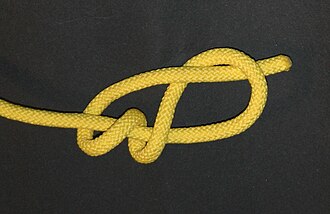m (30 revision(s) from w:Stevedore knot) |
|||
| (10 intermediate revisions by the same user not shown) | |||
| Line 1: | Line 1: | ||
{{Knot-details | {{Knot-details | ||
| − | | name= | + | | name= Stevedore knot |
| − | | image= Double_eight_- | + | | image= Double_eight_-2.JPG |
| − | | names= | + | | names= Double figure eight |
| type= stopper | | type= stopper | ||
| strength= | | strength= | ||
| − | | origin= | + | | origin= |
| − | | related= [[Figure-of-eight knot]], [[ | + | | related= [[Figure-of-eight knot]], [[Overhand knot]], [[Figure-of-nine loop]], [[Ashley's stopper knot]] |
| releasing= Non-jamming | | releasing= Non-jamming | ||
| − | | uses= To provide a | + | | uses= To provide a bulky, secure-when-slack stopper |
| caveat= | | caveat= | ||
| − | | abok_number= | + | | abok_number= #456, #522 |
}} | }} | ||
| − | ''' | + | The '''Stevedore knot''' is a [[Stopper (knot)|stopper knot]], often tied near the end of a [[rope]]. It is more bulky and less prone to jamming than the closely related [[figure-of-eight knot]]. |
| + | ==Naming== | ||
| − | [[ | + | There is a lack of consensus among knot experts regarding the origin of the name. Many sources, including ''[[The Ashley Book of Knots]]'', suggest the knot was used by [[stevedore]]s in their work loading and unloading [[ship]]s. To raise and lower cargo they used large [[block (sailing)|blocks]] and these required a larger stopper knot to prevent the line from running completely through the block.<ref name="ashley85">Clifford W. Ashley, ''The Ashley Book of Knots'' (New York: Doubleday, 1944), 85.</ref> |
| + | However, in ''The Art of Knotting & Splicing'', Cyrus Day disagrees, stating "the name originated in a pamphlet issued about 1890 by the C.W. Hunt Company, which sold rope under the name Stevedore. It was subsequently adopted by dictionaries, engineers' handbooks, and other works of reference, and it is now firmly established in books, if not in the vocabulary of seamen."<ref name="aksday">Cyrus Lawrence Day, ''The Art of Knotting and Splicing, 4th ed.'' (Annapolis: Naval Institute Press, 1986), 40.</ref> | ||
| − | + | ==Tying== | |
| + | [[Image:Double_eight_-1.JPG|thumb|Stevedore knot before tightening]] | ||
| + | The knot is formed by following the steps to make a figure-of-eight knot, but the working end makes an additional [[round turn]] around the standing part before the end passes back through the initial loop. | ||
| − | == | + | ==References== |
| − | + | <references/> | |
| − | |||
| − | |||
| − | |||
| − | == | + | ==External links== |
| − | * http://www.scoutingresources.org.uk/ | + | * http://www.scoutingresources.org.uk/knots_stoppersstevedore.html |
Revision as of 02:45, 21 June 2007
The Stevedore knot is a stopper knot, often tied near the end of a rope. It is more bulky and less prone to jamming than the closely related figure-of-eight knot.
Naming
There is a lack of consensus among knot experts regarding the origin of the name. Many sources, including The Ashley Book of Knots, suggest the knot was used by stevedores in their work loading and unloading ships. To raise and lower cargo they used large blocks and these required a larger stopper knot to prevent the line from running completely through the block.&
However, in The Art of Knotting & Splicing, Cyrus Day disagrees, stating "the name originated in a pamphlet issued about 1890 by the C.W. Hunt Company, which sold rope under the name Stevedore. It was subsequently adopted by dictionaries, engineers' handbooks, and other works of reference, and it is now firmly established in books, if not in the vocabulary of seamen."&
Tying
The knot is formed by following the steps to make a figure-of-eight knot, but the working end makes an additional round turn around the standing part before the end passes back through the initial loop.

